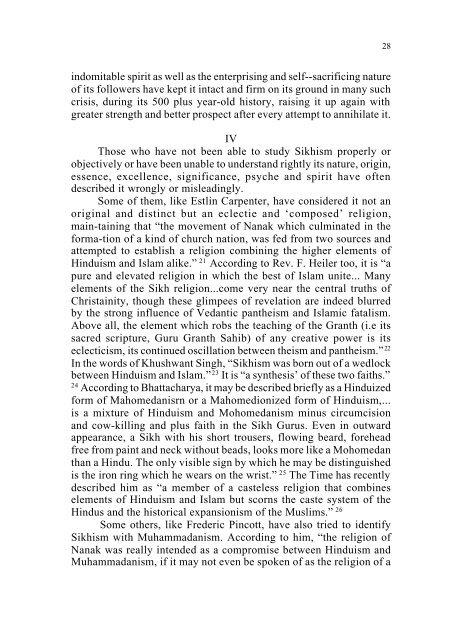Fundamental Issues Sikh Studies - Global Sikh Studies
Fundamental Issues Sikh Studies - Global Sikh Studies
Fundamental Issues Sikh Studies - Global Sikh Studies
Create successful ePaper yourself
Turn your PDF publications into a flip-book with our unique Google optimized e-Paper software.
28<br />
indomitable spirit as well as the enterprising and self-sacrificing nature<br />
of its followers have kept it intact and firm on its ground in many such<br />
crisis, during its 500 plus year-old history, raising it up again with<br />
greater strength and better prospect after every attempt to annihilate it.<br />
IV<br />
Those who have not been able to study <strong>Sikh</strong>ism properly or<br />
objectively or have been unable to understand rightly its nature, origin,<br />
essence, excellence, significance, psyche and spirit have often<br />
described it wrongly or misleadingly.<br />
Some of them, like Estlin Carpenter, have considered it not an<br />
original and distinct but an eclectie and ‘composed’ religion,<br />
maintaining that “the movement of Nanak which culminated in the<br />
formation of a kind of church nation, was fed from two sources and<br />
attempted to establish a religion combining the higher elements of<br />
Hinduism and Islam alike.” 21 According to Rev. F. Heiler too, it is “a<br />
pure and elevated religion in which the best of Islam unite... Many<br />
elements of the <strong>Sikh</strong> religion...come very near the central truths of<br />
Christainity, though these glimpees of revelation are indeed blurred<br />
by the strong influence of Vedantic pantheism and Islamic fatalism.<br />
Above all, the element which robs the teaching of the Granth (i.e its<br />
sacred scripture, Guru Granth Sahib) of any creative power is its<br />
eclecticism, its continued oscillation between theism and pantheism.” 22<br />
In the words of Khushwant Singh, “<strong>Sikh</strong>ism was born out of a wedlock<br />
between Hinduism and Islam.” 23 It is “a synthesis’ of these two faiths.”<br />
24<br />
According to Bhattacharya, it may be described briefly as a Hinduized<br />
form of Mahomedanisrn or a Mahomedionized form of Hinduism,...<br />
is a mixture of Hinduism and Mohomedanism minus circumcision<br />
and cow-killing and plus faith in the <strong>Sikh</strong> Gurus. Even in outward<br />
appearance, a <strong>Sikh</strong> with his short trousers, flowing beard, forehead<br />
free from paint and neck without beads, looks more like a Mohomedan<br />
than a Hindu. The only visible sign by which he may be distinguished<br />
is the iron ring which he wears on the wrist.” 25 The Time has recently<br />
described him as “a member of a casteless religion that combines<br />
elements of Hinduism and Islam but scorns the caste system of the<br />
Hindus and the historical expansionism of the Muslims.” 26<br />
Some others, like Frederic Pincott, have also tried to identify<br />
<strong>Sikh</strong>ism with Muhammadanism. According to him, “the religion of<br />
Nanak was really intended as a compromise between Hinduism and<br />
Muhammadanism, if it may not even be spoken of as the religion of a

















